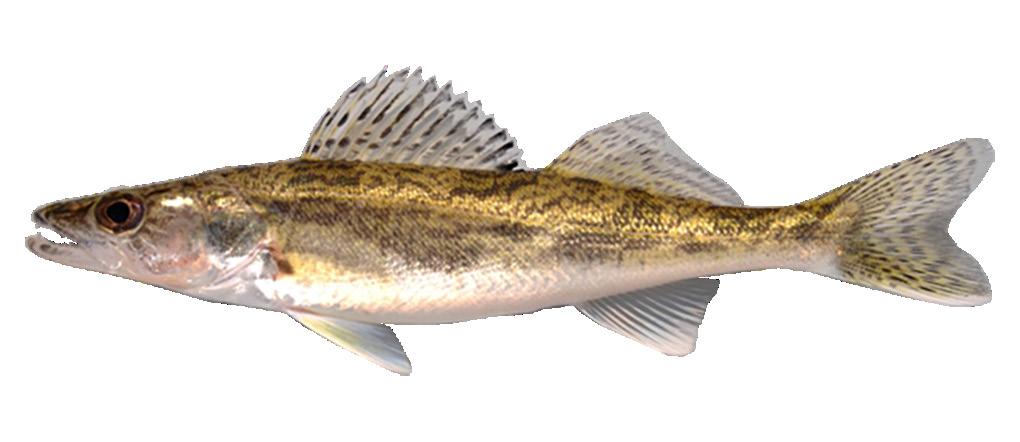
5 minute read
The Wild World Of Wisconsin's Hybrid Fish
Zach Wood
Zach Wood is a public information officer in the DNR’s Office of Communications.
In the famous film “Forrest Gump,” the title character aptly describes life as being “like a box of chocolates. You never know what you’re gonna get.”
With over 160 species of fish calling Wisconsin’s waters home, the same could be said for each and every cast into any of the state’s abundant lakes, rivers or streams.
Wisconsin anglers know to expect the unexpected. Yet, some fish are particularly noteworthy when encountered due to their unique appearance and (to those in the know) their fascinating lineage.
That’s right, we’re talking about Wisconsin’s hybrid fish! Here’s a look at some of the state’s fantastic fish and where to find them.
Saugeye

A saugeye, as the portmanteau suggests, is a cross between a sauger and a walleye, both native to Wisconsin waters. This hybridization occurs naturally in environments where both walleye and sauger populations are present, so anglers hoping to catch one should focus their efforts on Wisconsin’s larger rivers and the Winnebago System.
According to Joe Hennessy, DNR’s treaty coordinator and walleye expert: “Saugeye tend to grow quickly due to a phenomenon known as ‘hybrid vigor’ and will typically grow to larger sizes than a normal sauger, although still smaller than what can be seen in large walleye.”
Like their larger, more famous parent, saugeye make great table fare, Hennessy added.
Tiger Musky

There is likely no more famous or ferocious hybrid fish cruising Wisconsin’s waters than the famed tiger musky. These sterile fish, a cross of northern pike males and muskellunge females, are some of the most striking fish you’ll find in fresh water.
Tiger muskies occur naturally in many waters across the state where northern pike and musky are present. Like both parents, they are voracious predators with the capacity to test an angler’s willpower and equipment.
These fish grow faster than a pure musky, although they do not attain the same maximum size. That’s nothing to sneeze at, though, as the world record tiger musky — caught right here in Wisconsin! — weighed a whopping 51 pounds, 3 ounces.
“Tigers” have irregular light vertical bands on a dark background; rounded caudal, pectoral and pelvic fins; five to seven pores on each side of the lower jaw; and fully or partially scaled cheeks and partially scaled operculum (the flap over the gills).
Hybrid (Or Gray) Crappie

A hybrid crappie, also known as a gray crappie, is the byproduct of a black crappie (typically female) and a white crappie (typically male), hence why some call them gray crappie. These hybrids occur naturally in waters where both white and black crappie are present.
The hybrid grays tend to look very similar to black crappie, although they will often grow to larger sizes than either parent species due to hybrid vigor, said Max Wolter, DNR fisheries biologist.
“A lot of the really large ‘black crappies’ we hear about from our local anglers on certain lakes are actually hybrids — that’s why they are so big,” he said.
Hybrid Sunfish

Wisconsin is home to a number of sunfish species, and many of them are genetically compatible with each other, meaning many of Wisconsin’s waters contain hybrid sunfish — although plenty of anglers refer to almost all of them as bluegills.
Hybrids share traits from both of their parent sunfish species, which already look somewhat alike, so hybrids can be difficult to identify, even by the experts. Perhaps the most common sunfish hybrid is the cross between a bluegill and pumpkinseed, said Alex Latzka, DNR fisheries biologist.
“These are our two most common sunfish species,” Latzka said. “They are native and have strong populations throughout much of the state, so they are encountered more frequently than hybrids of the rarer warmouth or long-ear or orange-spotted sunfish.”
Tiger Trout

Although not very well known outside of the trout-fishing community, perhaps no hybrid fish is more prized and prestigious than the tiger trout. Catching one of these gorgeous fish, sterile crosses between a female brown trout and a male brook trout, is a bucket-list item for many trout anglers.
Tiger trout display unusual markings found in neither parent, making them a truly unique sight to behold in a net. Add to that an inherent scarcity in the wild, only appearing in areas where brook and brown trout share spawning grounds, and it’s easy to see why they carry the cachet they do in the angling world.
Learn More
Regardless of their target species, all Wisconsin anglers should familiarize themselves with the state’s fishing regulations, bag limits, length requirements and any special rules in place for the waters where they’re fishing.
For those looking for new places to explore or more information on their favorite local lake, check out the DNR’s new Wisconsin Fishing Finder tool. It’s a one-stop shop for regulations, launch locations and access points, stocking information and more.
See you on the water, and here’s to tight lines!

